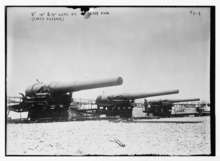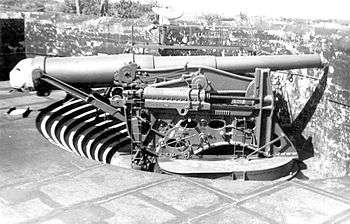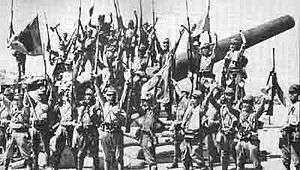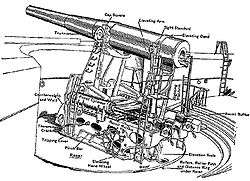12-inch gun M1895
| 12-inch gun M1895 | |
|---|---|
|
12-inch M1895 coastal defense gun being fired by lanyard | |
| Type | Coastal artillery |
| Place of origin | United States |
| Service history | |
| In service | 1895–1945 |
| Used by | United States Army |
| Wars | World War I, World War II |
| Production history | |
| Designer | Watervliet Arsenal |
| Designed | 1888 |
| Manufacturer | Watervliet Arsenal, Bethlehem Steel, possibly others |
| Variants | M1888, M1895, M1900 |
| Specifications | |
| Weight | 115,000 pounds (52,163 kilograms) (M1895) |
| Length | 442.56 inches (11.241 meters) |
| Barrel length | 35 calibers (442.56 inches; 11.241 meters) |
|
| |
| Shell |
separate loading, 975 pounds (442 kg) AP, 1,070 pounds (490 kg) AP shot & shell[1] |
| Caliber | 12 in (305 mm) |
| Breech | Interrupted screw, De Bange type |
| Carriage | M1891 gun lift, M1892 or M1897 barbette, M1896, M1897 or M1901 disappearing, M1917 long-range barbette from 1920[2] |
| Traverse |
disappearing: 170° (varied with emplacement), long-range M1917 barbette: 360° (145° casemated), railway: 10° |
| Maximum firing range |
disappearing: 18,400 yards (16,800 m), long-range M1917 barbette: 30,100 yards (27,500 m), railway: 30,100 yards (27,500 m)[3] |
| Feed system | hand |
The 12-inch coastal defense gun M1895 (305 mm) and its variants the M1888 and M1900 were large coastal artillery pieces installed to defend major American seaports between 1895 and 1945. For most of their history they were operated by the United States Army Coast Artillery Corps. Most were installed on disappearing carriages, with early installations on low-angle barbette mountings. From 1919, 19 long-range two-gun batteries were built using the M1895 on an M1917 long-range barbette carriage. Almost all of the weapons not in the Philippines were scrapped during and after World War II.
History
In 1885, William C. Endicott, President Grover Cleveland's secretary of war, was tasked with creating the Board of Fortifications to review seacoast defenses. The findings of the board illustrated a grim picture of existing defenses, and in its 1886 report recommended a massive $127 million construction program of breech-loading cannons, mortars, floating batteries, and submarine mines for some 29 locations on the US coastline. Most of the board's recommendations were implemented. Coast artillery fortifications built between 1885 and 1905 are often referred to as "Endicott Period" fortifications.


_(14801701763).jpg)
Watervliet Arsenal designed the gun and built the barrels. For several years, difficulties were encountered in building a disappearing carriage for the 12-inch gun. One alternative was the M1891 gun lift carriage, with the gun mounted on a large steam-powered elevator. Only one battery of this type was built, at Fort Hancock, New Jersey. When this proved to be too complex, guns were mounted on low-angle M1892 or M1897 barbette carriages. Eventually, the guns were mounted on M1896, M1897, or M1901 disappearing carriages designed by Bethlehem Steel; when the gun was fired, it dropped behind a concrete or earthen wall for protection from counter-battery fire. Bethlehem later built barrels as well.
After the Spanish–American War, the government wanted to protect American seaports in the event of war, and also protect newly gained territory, such as the Philippines and Cuba, from enemy attack. A new Board of Fortifications, under President Theodore Roosevelt's secretary of war, William Taft, was convened in 1905. Taft recommended technical changes, such as more searchlights, electrification, and, in some cases, less guns in particular fortifications. The seacoast forts were funded under the Spooner Act of 1902 and construction began within a few years and lasted into the 1920s. The defenses of the Philippines on islands in Manila Bay were built under this program.[4]
Railway mounting
After the American entry into World War I, the army recognized the need for large-caliber railway guns for use on the Western Front. Among the weapons available were 45 12-inch guns, to be removed from fixed defenses or taken from spares. At least 12 were mounted on railway carriages by mid-1919; it is unclear how many more were eventually mounted.[5] A detailed description of the railway mounting is given in Railway Artillery, Vol. I by Lt. Col. H. W. Miller.[6] Like almost all US-made railway guns of World War I (the notable exception being the US Navy's 14"/50 caliber railway guns), these never left the US.[7] Almost all were returned to coastal defenses after the war; however, one survived for experimental purposes at the Naval Surface Warfare Center Dahlgren Division until it was transferred to the U.S. Army Ordnance Training and Heritage Center at Fort Lee, Virginia in the 2000s.
Long-range mounting


Also during World War I, it was recognized that naval guns were rapidly improving and longer-range weapons were needed. Fourteen two-gun and two one-gun batteries were constructed with M1895 guns on the new M1917 long-range barbette carriage, which allowed an elevation of 35 degrees, compared to 15 degrees for the disappearing carriages. This increased the range from 18,400 yards (16,800 m) to 30,100 yards (27,500 m).[8] These batteries were mostly in the continental United States, with the two one-gun batteries on Corregidor in the Philippines.[9][10] The guns were originally in open mounts, but most were later casemated against air attack, probably around 1940 as World War II approached the United States. The batteries in the Philippines, however, were not casemated, as the 1923 Washington Naval Treaty prohibited further fortification of US and Japanese Pacific-area possessions.
World War II
Along with other coast artillery weapons, the 12-inch guns in the Philippines saw action in the Japanese invasion in World War II. Since they were positioned against a naval attack, they had mostly armor-piercing ammunition and were poorly sited to engage the Japanese (although they did have 360° fire due to lack of casemates), and the open mountings were vulnerable to air and high-angle artillery attack.

Three additional long-range casemated batteries were constructed during the war, at Fort Miles, Delaware, San Juan, Puerto Rico, and on Sullivan's Island near Fort Moultrie in the Harbor Defenses of Charleston, South Carolina. With the additional construction of 16-inch gun batteries at most harbor defenses, all guns on disappearing carriages were scrapped in 1943–44. The long-range batteries' guns were scrapped soon after the war ended.
M1895 12-inch coastal artillery batteries
- Battery Varnum (two 12-inch M1888 guns on barbette carriages; 1903–1943 Fort Wetherill, Jamestown, RI
- Battery Wheaton (two 12-inch M1888 guns on disappearing carriages; 1908–1945 Fort Wetherill, Jamestown, RI
- Battery Torbert (three guns on M1896 carriages, Fort Delaware, New Castle County, Delaware, installed 1901, deactivated 1940, guns sent to Puerto Rico)
- Battery Pensacola (two guns on M1897 carriages, Fort Pickens, Florida, installed 1898, deactivated 1934)
- Battery Kirby (two guns on M1897 carriages, Fort Baker, California, installed 1900, deactivated 1941, shipped to Battery Cheney, Fort Mills, Corregidor)
- Battery Duportail (two guns, Fort Morgan (Alabama), installed 1900 and deactivated 1923)
- Battery Lancaster (two guns on M1897 carriages, Fort Winfield Scott, California, installed 1901, dismounted 1918)
- Battery Chester (two guns on M1897 carriages, Fort Miley, California, installed 1902; one gun removed in 1918 and the other in 1943)
- Battery DeRussy (three guns on M1901 carriages, Fort Monroe, Virginia, installed 1904 and deactivated in 1944)
- Battery Parrott (two M1895 12-inch guns replaced two M1900 12-inch guns (installed 1906) in 1928, all on M1901 carriages; Fort Monroe, Virginia, installed 1928 and deactivated in 1943, rebuilt as AMTB 90mm battery)[11]
- Battery Mahan (two guns on M1897 carriages, Fort Totten, New York, installed 1900 and deactivated and shipped overseas in 1918)
- Battery Ayres (two guns on M1897 carriages, Fort Wadsworth, Richmond County, New York, installed 1902 and deactivated in 1942)
- Battery Hudson (one gun on M1896 carriage, Fort Wadsworth, Richmond County, New York, installed 1909 and deactivated in 1918)
- Battery Butterfield (two guns on M1897 carriages, Fort H.G. Wright, Fishers Island, Suffolk County, New York, installed 1900 and deactivated in 1944)
- Battery Crockett (two guns on M1901 carriages, Fort Mills, Corregidor, Philippine Islands, installed 1911; captured by the Japanese 1942; recaptured 1945)
- Battery Cheney (two guns on M1901 carriages, Fort Mills, Corregidor, Philippine Islands, installed 1910; captured by the Japanese 1942; recaptured 1945)
- Battery Wheeler (two guns on M1901 carriages, Fort Mills, Corregidor, Philippine Islands, installed 1909; captured by the Japanese 1942; recaptured 1945)
- Battery Hearn (one M1895MII gun on M1917 carriage, Fort Mills, Corregidor, Philippine Islands, installed 1921; captured by the Japanese 1942; recaptured 1945)
- Battery Smith (one M1895MII gun on M1917 carriage, Fort Mills, Corregidor, Philippine Islands, installed 1921; captured by the Japanese 1942; recaptured 1945)
- BCN 519 (two M1895MII guns, Fort Miles, Delaware, installed 1943; abandoned 1958)
Additional batteries, including 16 two-gun batteries with long-range M1917 carriages, were located around the United States and its possessions.[12][13][14]
Specifications
Variations
- M1888 rifle 12" 440" 117,127 lb
- M1888MI rifle 12" 440" 117,127 lb
- M1888MII rifle 12" 440" 117,127 lb
- M1895 rifle 12" 442.56" 115,000 lb
- M1895MI rifle 12" 442.56" 115,000 lb
- M1900 rifle 12" 480" 132,380 lb

The M1895MI weighed 52 tons and the M1901 carriage weighed 251 tons. The projectile weight for all M1895 guns was 1,046 pounds. Each shell used 318 pounds of powder, but this was varied depending on range. The projectile achieved a muzzle velocity of 2,250 feet per second. The M1901 disappearing carriage could elevate 15 degrees maximum; earlier models could not elevate that much until the rear mounting bracket was changed from a centerline to an upper position in the M1901. The M1901 could traverse 170 degrees, but some M1895MII emplacements could traverse 210 degrees. The M1895MII had a range of over 29,000 yards (26 kilometers).[15]
Surviving examples
No M1888 or M1900 weapons survive.[16]
- One 12-inch gun M1895MIA4 (#1 Watervliet) on Barbette Carriage M1917 (#31 Eng. Machine), Battery Smith, Fort Mills, Corregidor Island, Philippines
- One 12-inch gun M1895MIA4 (#6 Watervliet) on Barbette Carriage M1917 (#30 Eng. Machine), Battery Hearn, Fort Mills, Corregidor Island, Philippines
- One 12-inch gun M1895MIA4 (#8 Watervliet) (spare gun), Battery Hearn, Fort Mills, Corregidor Island, Philippines
- Two 12-inch guns M1895 (#13 Bethlehem & #27 Watervliet) on disappearing carriages M1901 (#14 and #15 Watertown), Battery Crockett, Fort Mills, Corregidor Island, Philippines
- One 12-inch gun M1895 (#8 Bethlehem) (spare gun), Battery Crockett, Fort Mills, Corregidor Island, Philippines
- Two 12-inch guns M1895 (#37 & #12 Watervliet) on disappearing carriages M1901 (#16 and #17 Watertown), Battery Cheney, Fort Mills, Corregidor Island, Philippines
- One 12-inch gun M1895 (#16 Watervliet) (may be spare gun for Battery Cheney), Bottomside Area, Fort Mills, Corregidor Island, Philippines
- One 12-inch gun M1895 (#36 Watervliet) (remains of disappearing carriage in front of the parapet), Battery Wheeler, Fort Mills, Corregidor Island, Philippines
- One 12-inch gun M1895 (#7 Bethlehem) on disappearing carriage M1901 (#2 Watertown), Battery Wheeler, Fort Mills, Corregidor Island, Philippines
- One 12-inch gun M1895 (#10 Bethlehem) (spare gun), Battery Wheeler, Fort Mills, Corregidor Island, Philippines
- One 12-inch gun M1895MIA1 (#19) on railway mount M1918 (#9 Marion steam shovel), U.S. Army Ordnance School, Fort Lee, VA.
- One 12-inch gun M1895 at Fort Miles, Lewes, Delaware[17]
See also
- List of U.S. Army weapons by supply catalog designation
- Coastal artillery
- List of the largest cannon by caliber
- Seacoast defense in the United States
- Battle of Corregidor
- Fort Heath
- Coast Artillery fire control system
- Watervliet Arsenal
- Fort Miles
- United States War department forms
- 10-inch M1895 gun
References
- ↑ Berhow, p. 61
- ↑ Berhow, pp. 130–155
- ↑ Berhow, p. 61
- ↑ Berhow, Mark A. and McGovern, Terrance C., American Defenses of Corregidor and Manila Bay 1898–1945, Osprey Publishing Ltd.; 1st edition, 2003; pages 7–8.
- ↑ Hogg, Ian V. (1998). Allied Artillery of World War I. Ramsbury, Wiltshire, UK: The Crowood Press, Ltd. pp. 141–142. ISBN 1-86126-104-7.
- ↑ Miller, H. W., LTC, USA Railway Artillery, Vols. I and II, 1921, Vol. I, pp. 197–250
- ↑ US Army Railway Artillery in World War I
- ↑ Berhow, p. 61
- ↑ Coast Defense Study Group fort and battery list
- ↑ Berhow, pp. 224–226
- ↑ FortWiki on Battery Parrott, Ft. Monroe
- ↑ Search on FortWiki for M1895 12-inch gun
- ↑ Berhow, pp. 200–223
- ↑ Berhow, pp. 224–226
- ↑ Berhow, Mark A. and McGovern,Terrance C. American Defenses of Corregidor and Manila Bay 1898–1945, Osprey Publishing Ltd.; 1st edition, 2003; page 59.
- ↑ Berhow, pp. 229-230
- ↑ Gun is located at 38°46′34″N 75°05′14″W / 38.7761°N 75.0872°W
- Berhow, Mark A., Ed. (2004). American Seacoast Defenses, A Reference Guide, Second Edition. CDSG Press. ISBN 0-9748167-0-1.
- Lewis, Emanuel Raymond (1979). Seacoast Fortifications of the United States. Annapolis: Leeward Publications. ISBN 978-0-929521-11-4.
- Miller, H. W., LTC, USA (1921). Railway Artillery, Vols. I and II. Washington: US Government Printing Office. pp. 197–250.
General references
- Berhow, Mark A. and McGovern, Terrance C. American Defenses of Corregidor and Manila Bay 1898–1945, Osprey Publishing Ltd.; 1st edition, 2003. ISBN 1841764272
- Description of Seacoast Guns 8, 10, 12, 14, 16-inch
- Artillery circular 1893, page 195
- Handbook of Ordnance Data, 15 November 1918, page 97
- America's Munitions 1917-1918, page 91
- Ordnance Supply Manual by George L. Lohrer, United States Army, Ordnance Dept, 1904, page 115
- Instructions for mounting, using and caring for Barbette carriage, model of 1917 for 12-inch gun, model of 1895 MI (1917)
- FM 4-80 Seacoast Artillery: Service of the Piece – 12-Inch and 14-Inch Guns (Disappearing Carriage)
- SNL E-8
- SNL E-19
- SNL E-25
- SNL E-35
External links
| Wikimedia Commons has media related to 12 inch Coast Gun M1895. |
